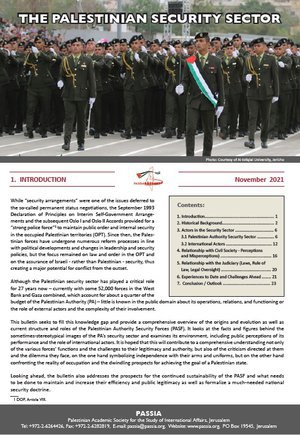The Palestinian Security Sector
While “security arrangements” were one of the issues deferred to the so-called permanent status negotiations, the September 1993 Declaration of Principles on Interim Self-Government Arrangements and the subsequent Oslo I and Oslo II Accords provided for a “strong police force”1 to maintain public order and internal security in the occupied Palestinian territories (OPT). Since then, the Palestinian forces have undergone numerous reform processes in line with political developments and changes in leadership and security policies, but the focus remained on law and order in the OPT and on the assurance of Israeli - rather than Palestinian - security, thus creating a major potential for conflict from the outset.
Although the Palestinian security sector has played a critical role for 27 years now – currently with some 52,000 forces in the West Bank and Gaza combined, which account for about a quarter of the budget of the Palestinian Authority (PA) – little is known in the public domain about its operations, relations, and functioning or the role of external actors and the complexity of their involvement.
This bulletin seeks to fill this knowledge gap and provide a comprehensive overview of the origins and evolution as well as current structure and roles of the Palestinian Authority Security Forces (PASF). It looks at the facts and figures behind the sometimes-stereotypical images of the PA’s security sector and examines its environment, including public perceptions of its performance and the role of international actors. It is hoped that this will contribute to a comprehensive understanding not only of the various forces’ functions and the challenges to their legitimacy and authority, but also of the criticism directed at them and the dilemma they face, on the one hand symbolizing independence with their arms and uniforms, but on the other hand confronting the reality of occupation and the dwindling prospects for achieving the goal of a Palestinian state.
Looking ahead, the bulletin also addresses the prospects for the continued sustainability of the PASF and what needs to be done to maintain and increase their efficiency and public legitimacy as well as formalize a much-needed national security doctrine.

